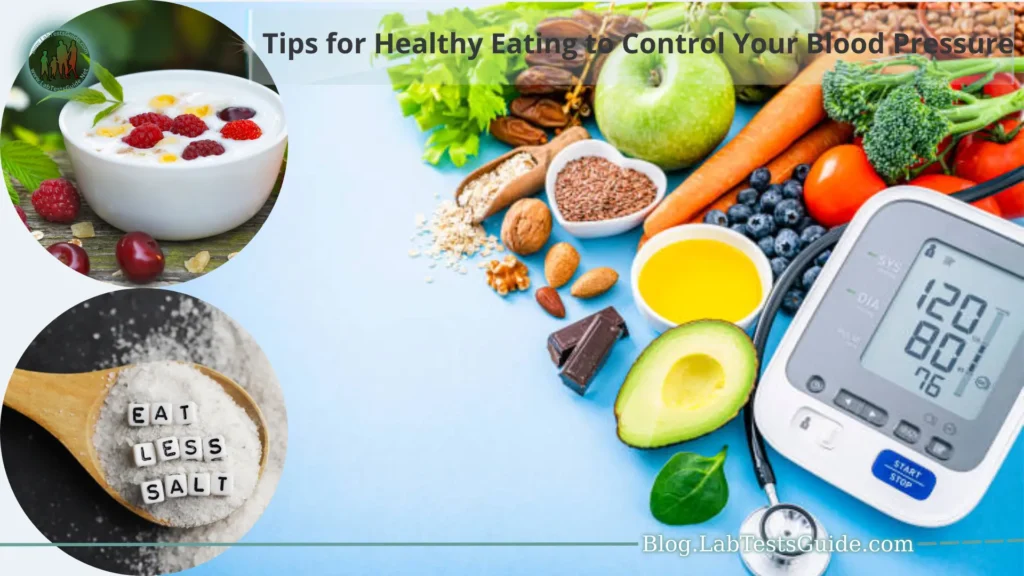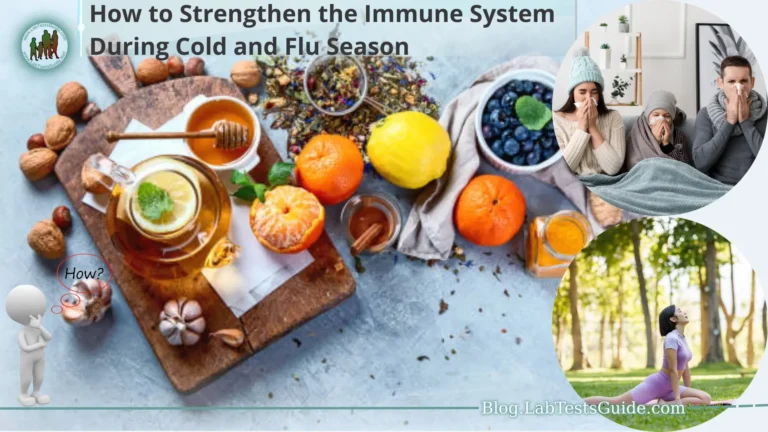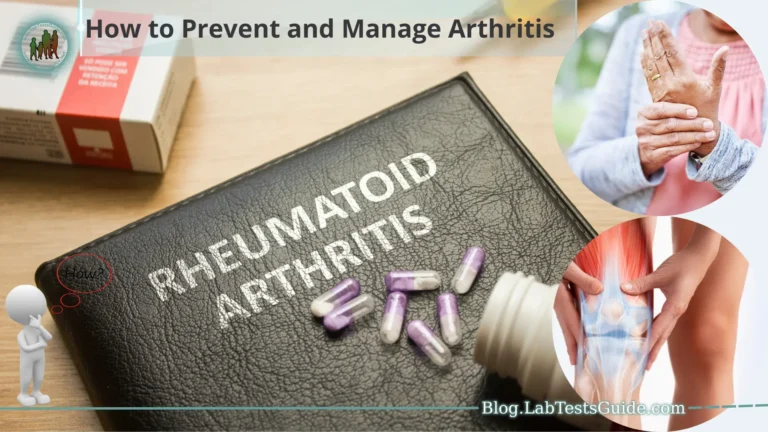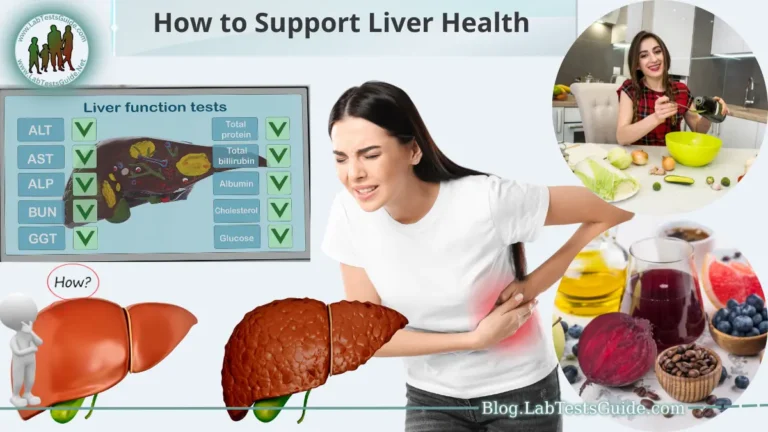High blood pressure, or hypertension, is a common condition that affects many people around the world. While medications can be effective in controlling your blood pressure, making changes to your diet can also be an important part of managing the condition. Eating a healthy, balanced diet can help lower blood pressure and reduce the risk of complications.

Eat a variety of fruits and vegetables
Here are some tips for incorporating more fruits and vegetables into your diet to control your blood pressure:
- Try to eat 5 servings per day: Try to eat at least 5 servings of fruits and vegetables per day. This can include fresh, frozen, or canned options.
- Choose a variety of colors: Different colors of fruits and vegetables provide different nutrients, so try to eat a variety of colors. For example, dark leafy greens are high in calcium, while red and orange fruits and vegetables are high in vitamin C.
- Eat fruits and vegetables: Eat fruits and vegetables instead of processed snacks or high-sodium options. Carrots, cucumbers, apples, and berries are all great options.
- Add Vegetables to Your Meals: Add additional vegetables to your meals, such as adding spinach to your omelet or broccoli to your stir-fry.
Choose whole grains
Whole grains are high in fiber and can help lower blood pressure. Look for whole grain bread, pasta, and rice instead of their refined counterparts.
Reduce your sodium intake:
To reduce your sodium intake, you can:
- Read food labels: Check the labels of packaged foods for their sodium content. Choose low-sodium or no-salt-added options whenever possible.
- Cooking at home: Preparing your meals at home allows you to control the amount of sodium in your food. Use fresh ingredients and herbs and spices to add flavor instead of relying on salt.
- Limit processed foods: Processed and packaged foods tend to be high in sodium. Avoid foods like canned soups, frozen dinners, and snack foods.
- Be careful when eating out: Restaurant meals can be high in sodium, so be careful about your choices when eating out. Ask that your food be prepared without added salt or sauces, and avoid adding salt to your food.
Reducing your sodium intake may take some getting used to, but it can help improve your overall health and lower your blood pressure.
Eat more potassium-rich foods:
Eating more potassium-rich foods is another important step in controlling your blood pressure. Potassium is a mineral that can help counteract the effects of sodium in your body and lower your blood pressure.
Some foods that are high in potassium include:
- Sweet potatoes
- Bananas
- Avocados
- Spinach
- Tomatoes
- Oranges
- Yogurt
- Beans and lentils
- Salmon
- Mushrooms
It is important to note that some medications, such as potassium-sparing diuretics, can increase the amount of potassium in your body to dangerous levels. If you are taking blood pressure medications, talk to your health care provider to determine the appropriate amount of potassium for your individual needs.
Incorporating more potassium-rich foods into your diet can be as simple as adding a banana to your morning cereal or having a side of roasted sweet potatoes with dinner. Try to eat at least 3-5 servings of potassium-rich foods per day to reap the benefits for your blood pressure and overall health.
How to Control blood pressure with Lifestyle Changes ?
Here are some tips that may be beneficial.
- Exercise regularly: Exercise is one of the most effective ways to lower blood pressure naturally. Try to get at least 30 minutes of moderate exercise on most days of the week.
- Reduce stress: Chronic stress can increase blood pressure. Try practicing relaxation techniques like meditation, deep breathing, or yoga to help reduce stress.
- Lose weight: Being overweight can put pressure on your heart and increase your blood pressure. Losing weight through a healthy diet and exercise can help lower blood pressure.
- Limit caffeine and alcohol: Drinking too much caffeine or alcohol can increase your blood pressure. Limit your intake to one to two cups of coffee per day and one drink per day for women and two drinks per day for men.
- Eat a healthy diet: A diet rich in fruits, vegetables, whole grains, and lean protein can help lower blood pressure. Limit your intake of sodium and processed foods.
- Get enough sleep: Sleep plays an important role in regulating blood pressure. Aim for 7-8 hours of sleep per night.
- Try natural remedies: Some natural remedies can also help lower blood pressure, such as garlic, hibiscus tea, and fish oil supplements. However, it’s important to talk to your health care provider before trying any new remedies, as some may interact with medications or have side effects.
Incorporate lean protein:
Here are some examples of lean protein sources.
- Skinless chicken or turkey breast
- Fish, such as salmon, tuna, or mackerel
- Lean cuts of beef, such as sirloin or sirloin
- beans and lentils
- tofu or tempeh
- Low-fat dairy, such as milk, yogurt, and cheese
- Nuts and seeds, such as almonds or pumpkin seeds.
- When selecting protein sources, it’s important to choose lean options that are low in saturated and trans fats. These types of fats can increase cholesterol levels and contribute to high blood pressure.
Incorporating lean protein into your meals can be as simple as adding grilled chicken to a salad or dining on a piece of fish with grilled vegetables. Try to include a lean protein source with each meal to help keep your blood pressure in check.
Avoid sugary drinks and snacks:
Here are some tips for reducing your intake of sugary drinks and snacks.
- Drink water: Water is the best option to stay hydrated and avoid sugary drinks. Try to drink at least 8-10 glasses of water per day.
- Choose low-sugar drinks: If you prefer flavored drinks, choose options low in added sugars, such as unsweetened tea, flavored water, or sugar-free drinks.
- Read Food Labels: Check the labels of packaged foods for sugar content. Choose options low in added sugars or opt for fresh fruits or vegetables.
- Avoid processed snacks: Processed snacks, such as cookies, cakes, and candy, are often high in added sugars. Choose healthier snack options such as fresh fruit, nuts, or popcorn.
Cutting back on sugary drinks and snacks can take some getting used to, but it can help improve your overall health and lower your blood pressure. Try to limit your intake of added sugars to no more than 6 teaspoons per day for women and 9 teaspoons per day for men.
Control Blood Pressure by Food:
Here are some foods that can help to lower blood pressure.
- Leafy green vegetables: Leafy green vegetables, such as spinach, kale, and collard greens, are high in potassium, which can help lower blood pressure by counteracting the effects of sodium.
- Berries: Berries, such as strawberries, blueberries, and raspberries, are rich in flavonoids, which can help lower blood pressure by improving blood vessel function.
- Oats: Oats are a great source of soluble fiber, which can help lower cholesterol levels and lower blood pressure.
- Yogurt: Yogurt is a good source of calcium, which can help lower blood pressure. Choose low-fat or fat-free options to reduce your saturated fat intake.
- Fish: Fatty fish, such as salmon, tuna, and mackerel, are rich in omega-3 fatty acids, which can help lower blood pressure by reducing inflammation and improving blood vessel function.
- Seeds: Seeds, such as chia seeds and flax seeds, are high in potassium, magnesium, and fiber, all of which can help lower blood pressure.
- Garlic: Garlic has been shown to have a mild blood pressure-lowering effect and may also help lower cholesterol levels.
Incorporating these foods into your diet can be a great way to help lower your blood pressure. It’s also important to limit your intake of sodium and processed foods, as they can contribute to high blood pressure. Be sure to discuss any dietary changes you are considering with your healthcare provider to ensure they are appropriate for your individual needs.
FAQs
What is considered high blood pressure?
High blood pressure, also known as hypertension, is defined as having a systolic blood pressure of 130 mmHg or higher, or a diastolic blood pressure of 80 mmHg or higher.
How can I measure my blood pressure at home?
You can measure your blood pressure at home with a blood pressure monitor. Be sure to follow the manufacturer’s instructions and take readings at the same time each day for accuracy.
Can I lower my blood pressure without medication?
Yes, lifestyle changes such as a healthy diet, regular exercise, stress management, and smoking cessation can help lower blood pressure without medication. However, some people may still need medicine to control their blood pressure.
How much sodium should I consume each day?
The American Heart Association recommends consuming no more than 2,300 milligrams (mg) of sodium per day, with an ideal limit of no more than 1,500 mg per day for most adults.
Can certain foods increase blood pressure?
Yes, foods high in sodium, saturated and trans fats, and added sugars can increase blood pressure. It is important to limit your intake of these types of foods and focus on a healthy diet that includes plenty of fruits, vegetables, whole grains, lean protein, and low-fat dairy products.
What foods should I include in my diet to help lower my blood pressure?
Include plenty of fruits and vegetables, as they are rich in potassium and fiber, which can help regulate blood pressure. Choose lean protein sources such as poultry, fish, beans, and tofu. Options for whole grains like brown rice, whole wheat bread, and oats, which are high in fiber and can support heart health. Incorporate dairy or dairy alternatives that are low in fat and sodium.
What foods should I limit or avoid to control my blood pressure?
Limit your sodium (salt) intake, as high sodium levels can lead to high blood pressure. Avoid processed and fast foods, which are often high in sodium. Reduce your intake of saturated and trans fats found in fatty meats, fried foods, and many packaged snacks. Cut back on sugary beverages and foods with added sugars.
How can I make my meals more heart-healthy?
Cook at home more often, as this allows you to control the ingredients and portion sizes in your meals. Use herbs and spices to flavor your food instead of adding salt. Grill, bake, steam, or broil foods instead of frying them. Choose healthy fats like olive oil, avocados, and nuts in moderation.
What are some tips for reading food labels to manage blood pressure?
Check the nutrition facts label for the sodium content and aim for foods with lower sodium levels. Pay attention to serving sizes to avoid consuming too much sodium in a single serving. Look for “low-sodium,” “no added salt,” or “sodium-free” labels on packaged foods. Be mindful of hidden sources of sodium, such as canned soups, sauces, and processed meats.
Are there specific dietary patterns that can help with blood pressure control?
The Dietary Approaches to Stop Hypertension (DASH) diet is often recommended for managing blood pressure. It emphasizes fruits, vegetables, whole grains, lean protein, and low-fat dairy while reducing sodium intake. The Mediterranean diet, which includes olive oil, fish, nuts, and plenty of fruits and vegetables, has also been associated with better blood pressure control.
Conclusion:
In conclusion, controlling your blood pressure through diet and lifestyle changes is an important step in maintaining good health. Incorporating more fruits and vegetables, whole grains, lean protein, and low-fat dairy while reducing sodium, saturated and trans fats, and added sugars can help lower blood pressure. In addition, regular exercise, stress management, and quitting smoking can also help lower your blood pressure and reduce your risk of heart disease and other health problems. Remember to talk to your healthcare provider before making any dietary or lifestyle changes to ensure they are appropriate for your individual needs.






